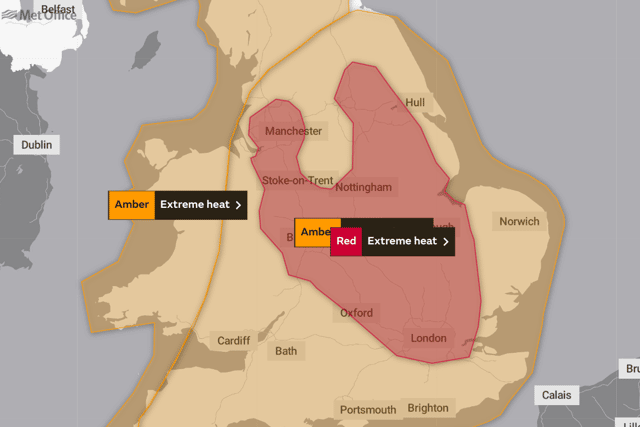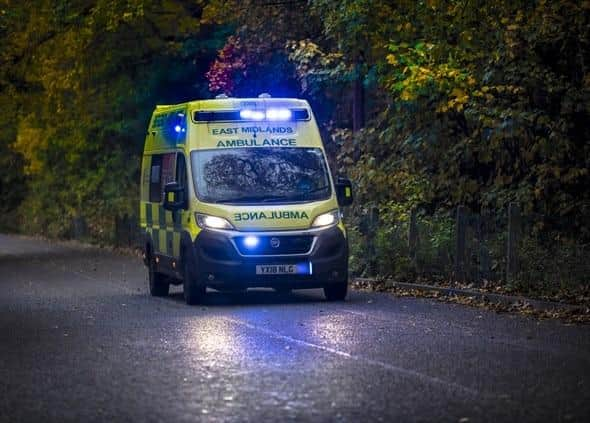Derbyshire heatwave LIVE: Everything known so far about school closures as Met Office predicts highs of 40°C
and live on Freeview channel 276
The Met Office warning covers both Monday and Tuesday and is now in place across parts of Derbyshire including Chesterfield, Matlock, Bakewell and Buxton.
It is a downgrade on the previous red weather alert issued for these areas last week, which warned of “serious illness or danger to life”.
Advertisement
Hide AdAdvertisement
Hide AdHowever, areas such as Bolsover, Clowne and Belper remain on the edge of the warnings with both red and amber alerts in place.
Temperatures are set to reach 40°C in parts of Derbyshire, according to the Met Office, with people across the country urged to stay at home and avoid travelling unless absolutely necessary.
Follow our live blog below for all the latest updates on the weather across the county and beyond.
Latest weather updates as temperatures set to top 40C in Derbyshire
Key Events
- Hottest day ever recorded in Derbyshire
- Fire calls to Derbyshire and Nottinghamshire’s call handlers increase by more than 312%
- Derbyshire schools remain closed today as others tell pupils to attend in sports kits
- Met Office predicts ‘exceptionally hot’ day with strong sunshine
- Chesterfield Royal Hospital implements changes to protect staff and patients in hot weather
What the Met Office red warning says
The Met Office has issued its first ever red warning for extreme heat covering both Monday and Tuesday - but what can people expect?


The warning reads:
- Population-wide adverse health effects experienced, not limited to those most vulnerable to extreme heat, leading to serious illness or danger to life. Government advice is that 999 services should be used in emergencies only; seek advice from 111 if you need non-emergency health advice.
- Substantial changes in working practices and daily routines will be required
- High risk of failure of heat-sensitive systems and equipment, potentially leading to localised loss of power and other essential services, such as water or mobile phone services
- Significantly more people visiting coastal areas, lakes and rivers, leading to an increased risk of water safety incidents
- Delays on roads and road closures, along with delays and cancellations to rail and air travel, with significant welfare issues for those who experience even moderate delays
Melting roads are likely as RAC urges motorists to avoid driving on Monday and Tuesday
RAC Breakdown spokesperson Rod Dennis said: ‘With a rare red weather warning for extreme heat in force there’s now every possibility a large than normal number of drivers will suffer breakdowns over the next few days. We anticipate there could be around 15-20 per cent more breakdowns on Monday and Tuesday, which equates to more than 1,000 extra people needing help each day.
“Such a large increase in people needing assistance is bound to put pressure on all breakdown services, so it’s essential drivers have an emergency kit with them to keep as safe as possible while they wait for help – ideally in a safe location in the shade.
“Carrying plenty of water, some non-perishable food, emergency medication if needed and a means of blocking out the sun – hats and an umbrella – are all important, as is a having a fully charged phone to be able to contact their breakdown provider or the emergency services if necessary.
“Our teams will be working tirelessly to rescue drivers who break down, but there is a lot drivers can do to avoid breaking down in the first place. This starts with checking the coolant and oil levels under the bonnet when the engine is cold. Oil should be topped up if it’s low, and if coolant isn’t between the ‘min’ and ‘max’ levels then drivers should top it up – or take it to a reputable garage to get it checked without delay.
“Drivers in vehicles without effective air conditioning should consider delaying any non-essential journeys by car over the next few days until temperatures begin to fall and the Met Office’s weather warning no longer applies, or use the car during the coolest parts of the day.
“This is particularly important advice for vulnerable people, including the very young and elderly, for whom the extremely high temperatures pose a clear health risk. We also want to remind drivers never to leave pets in a hot car, which can prove fatal.
“At these sorts of temperatures, melting roads are also likely – with blacker patches of tarmac being the most obvious sign. Drivers therefore shouldn’t be surprised to see some gritting trucks out, as spreading a fine granite dust can help improve vehicle grip on softening road surfaces.
“Drivers also shouldn’t be alarmed if they see water underneath their vehicles, which is normally just condensation coming from the air conditioning unit.”
‘Keep yourself healthy’ plea from Derbyshire ambulance bosses


Ambulance bosses are warning residents and holidaymakers across Derbyshire to take steps now to keep themselves healthy as temperatures continue to rise.
East Midlands Ambulance Service has urged people to take take responsibility for keeping themselves well during the hot weather, in a bid to protect its crews.
Advice includes: drinking plenty of water to keep hydrated; staying in the shade or a cool part of the house; taking extra precautions to keep babies and young children cool and hydrated; and checking on elderly or vulnerable neighbours.
Level 4 UK Health Security Agency Heat Health Alert has been issued for Monday and Tuesday
This is level of alert is used when a heatwave is so severe and/or prolonged that its effects extend outside the health and social care system.
At this level, illness may occur among the fit and healthy, and not just in high-risk groups.
Dr Agostinho Sousa, Head of Extreme Events and Health Protection at UKHSA, said: “Heat-health alerts have now been issued to the majority of the country, with temperatures set to remain consistently high throughout the duration of the weekend and the start of next week.
“It is important to keep yourself hydrated and to find shade where possible when UV rays are strongest, between 11am and 3pm.
“If you have vulnerable family, friends and neighbours, make sure they are aware of how they can keep themselves protected from the warm weather.’’
Severn Trent issues message to customers on water over scorcher weekend
The water company said: “We’re set for a hot weekend, and we need your help to make sure there’s enough lovely water to keep your community hydrated.
“Do your bit by putting away the hoses and jet washers and turn off the tap when brushing your teeth. That way we’ll keep the water flowing for all. Thanks.”
“It is important people plan for the heat”, says Met Office as it issues first ever red heat warning


For the first time in Met Office history, a red warning for extreme heat has been issued in the UK – affecting areas across Derbyshire and beyond.
The red warning - which is the highest alert level possible - will be in place from Monday, July 18, to 11.59pm on Tuesday, July 19.
It comes as forecasters predict temperatures of up to 34°C to begin the week in Chesterfield, likely rising to an unbelievable 37°C on Tuesday.
Met Office Chief Meteorologist Paul Gundersen, said “Exceptional, perhaps record-breaking temperatures are likely early next week, quite widely across the red warning area on Monday, and focussed a little more east and north on Tuesday.
“Currently there is a 50 per cent chance we could see temperatures top 40°C and 80 cent we will see a new maximum temperature reached.
“Nights are also likely to be exceptionally warm, especially in urban areas. This is likely to lead to widespread impacts on people and infrastructure. Therefore, it is important people plan for the heat and consider changing their routines. This level of heat can have adverse health effects.”